How old are the fields of robotics and artificial intelligence? Many might trace their origins to the mid-twentieth century, and the work of people such as Alan Turing, who wrote about the possibility of machine intelligence in the ‘40s and ‘50s, or the MIT engineer Norbert Wiener, a founder of cybernetics. But these fields have prehistories — traditions of machines that imitate living and intelligent processes — stretching back centuries and, depending how you count, even millennia.
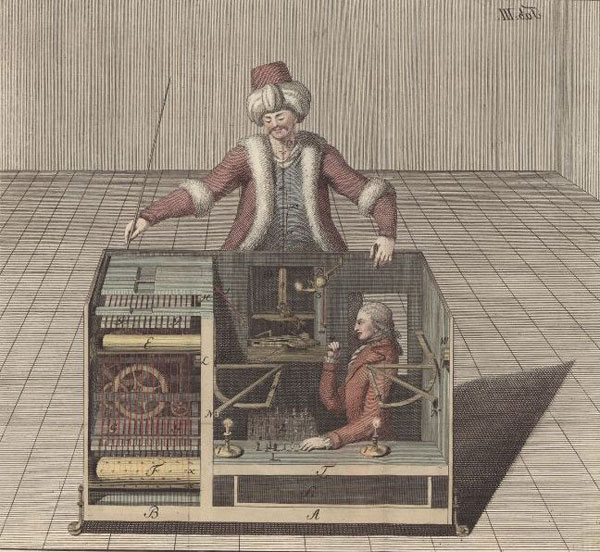 Coloured engraving from Joseph Racknitz%u2019s 1789 pamphlet which attempted to reveal the secret workings of William Kempelen%u2019s alleged chess-playing automaton %u201CThe Turk%u201D
Coloured engraving from Joseph Racknitz%u2019s 1789 pamphlet which attempted to reveal the secret workings of William Kempelen%u2019s alleged chess-playing automaton %u201CThe Turk%u201D
The word “robot” made its first appearance in a 1920 play by the Czech writer Karel Čapek entitled R.U.R., for Rossum’s Universal Robots. Deriving his neologism from the Czech word “robota,” meaning “drudgery” or “servitude,” Čapek used “robot” to refer to a race of artificial humans who replace human workers in a futurist dystopia. (In fact, the artificial humans in the play are more like clones than what we would consider robots, grown in vats rather than built from parts.)
There was, however, an earlier word for artificial humans and animals, “automaton”, stemming from Greek roots meaning “self-moving”. This etymology was in keeping with Aristotle’s definition of living beings as those things that could move themselves at will. Self-moving machines were inanimate objects that seemed to borrow the defining feature of living creatures: self-motion. The first-century-AD engineer Hero of Alexandria described lots of automata. Many involved elaborate networks of siphons that activated various actions as the water passed through them, especially figures of birds drinking, fluttering, and chirping.
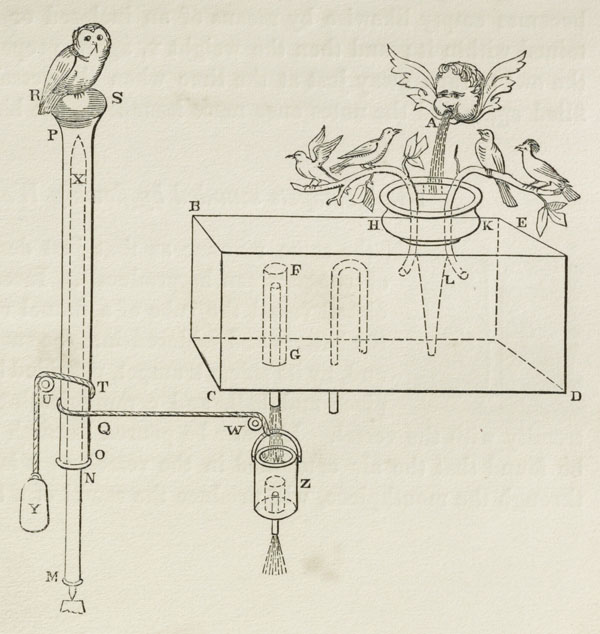 Illustration from an 1851 English edition of Hero%u2019s Pneumatica, in which he describes machines working on air, steam or water pressure
Illustration from an 1851 English edition of Hero%u2019s Pneumatica, in which he describes machines working on air, steam or water pressure
The siphon would have had a particular attraction to the ancient automaton-maker, in that it makes water travel upward, counter to what it would otherwise do. According to Aristotle, while living things moved themselves at will, inanimate things moved according to their natures: heavy things, made of earth or water, descended, while light things, made of air or fire, ascended. A siphon, by allowing water to ascend, appeared to violate Aristotle’s principle, and it also tends to work intermittently, and so further creating the illusion of wilful behavior.
Waterworks, including but not limited to ones using siphons, were probably the most important category of automata in antiquity and the middle ages. Flowing water conveyed motion to a figure or set of figures by means of levers or pulleys or tripping mechanisms of various sorts. A late twelfth-century example by an Arabic automaton-maker named Al-Jazari is a peacock fountain for hand-washing, in which flowing water triggers little figures to offer the washer first a dish of perfumed soap powder, then a hand towel.
Even more than in royal gardens and on noble estates, medieval and early Renaissance automata appeared in churches and cathedrals. Automaton Christs — muttering, blinking, grimacing on the Cross — were especially popular. A mechanical Christ on a crucifix, known as the Rood of Grace, attracted pilgrims to Boxley Abbey in Kent during the fifteenth century. This Jesus “was made to move the eyes and lipps by stringes of haire”. The Rood could move its hands and feet, nod its head, roll its eyes, and show “a well contented or displeased minde: byting the lippe, and gathering a frowning, forward, and disdainful face, when it would pretend offence: and shewing a most milde, amiable, and smyling cheere and countenaunce, when it woulde seeme to be well pleased”.
Mechanical devils were also to be found. Poised in sacristies, they made horrible faces, howled and stuck out their tongues. The Satan-machines rolled their eyes and flailed their arms and wings; some even had moveable horns and crowns.
The Florentine architect Filippo Brunelleschi even mechanized Paradise itself: “a Heaven full of living and moving figures could be seen as well as countless lights, flashing on and off like lightning”. While elsewhere, elaborately engineered hells rumbled with thunder and flashed with lightning, spewing forth writhing automaton serpents and dragons.
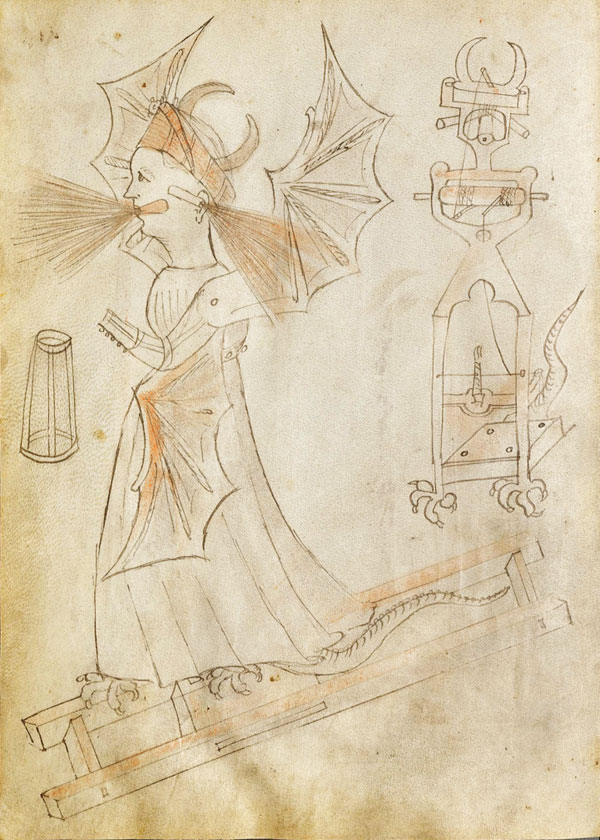 A mechanised creature, half-human half-serpent, from Johannes de Fontana%u2019s 15th-century manuscript Belli Corum instrumentorum liber cum figuris
A mechanised creature, half-human half-serpent, from Johannes de Fontana%u2019s 15th-century manuscript Belli Corum instrumentorum liber cum figuris
These machines helped inspire the idea that perhaps automata accomplished something deeper than merely entertaining tricks: perhaps they genuinely modeled the workings of nature. The French philosopher René Descartes made this case powerfully during the 1640s, arguing that the entire world, including living bodies, was essentially machinery composed of moving parts and could be understood in just the way a clockmaker understands a clock. His work was foundational to modern science in general, and to modern physiology in particular. In developing his mechanist model of science, Descartes invoked the lifelike machines all around him. Indeed, he lived for a time in Saint Germain en Laye and almost certainly visited the hydraulic grottoes of Henri IV, which he described in detail.
With the sixteenth-century advent of the pinned cylinder — a barrel with pins or bars sticking out, such as in a music box — even more complex lifelike machines were possible. Around this time, a new word also arose to describe human-like machines in particular: “android,” derived from Greek roots meaning “manlike.” This was the coinage of Gabriel Naudé, French physician and librarian, and personal doctor to none other than the automaton-loving Louis XIII.
Pinned cylinders were the programming devices in automata and automatic organs from around 1600. In 1650, the German polymath Athanasius Kircher offered an early design of a hydraulic organ with automata, governed by a pinned cylinder and including a dancing skeleton.
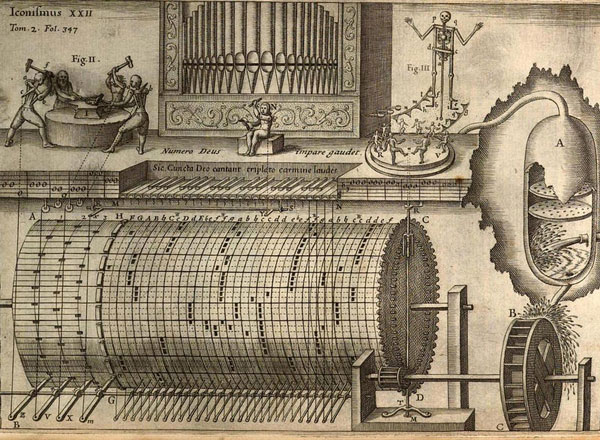 Kircher%u2019s fanciful design for a hydraulic organ, complete with dancing skeleton, featured in his Musurgia Universalis (1650)
Kircher%u2019s fanciful design for a hydraulic organ, complete with dancing skeleton, featured in his Musurgia Universalis (1650)
Of course, it’s an anachronism to call sixteenth- and seventeenth-century pinned cylinders “programming” devices. To be sure, there is a continuous line of development from these pinned cylinders to the punch cards used in nineteenth-century automatic looms (which automated the weaving of patterned fabrics), to the punch cards used in early computers, to a silicon chip. The designers of the automatic loom used automata and automatic musical instruments as their model; then Charles Babbage — the English mathematician who designed the first mechanical computers during the 1830s, the Analytical and Difference Engines — in turn used the automatic loom as his model. Indeed, one might consider a pinned cylinder to be a sequence of pins and spaces, just as a punch card is a sequence of holes and spaces, or zeroes and ones. Though it is important to remember that neither Babbage nor the designers of the automatic loom nor the automaton-makers thought of these devices in terms of programming or information, concepts which did not exist until the mid-twentieth century. For example, ideas about the division of labor inspired the Industrial-Revolution-era automatic looms as well as Babbage’s calculating engines — they were machines intended primarily to separate mindless from intelligent forms of work.
With pinned cylinders, beginning in the early part of the eighteenth century, people began to design automata that actually enacted the tasks they appeared to perform. The first simulative automata were designed in the 1730s by a Frenchman named Jacques Vaucanson, and quickly became the talk of Europe. Two were musicians, a “Piper” and a “Flutist”. The flutist had lips that flexed in four directions, delicate jointed fingers, and lungs made of bellows that gave three different blowing pressures. It was the first automaton musician actually to play an instrument, rather than being a music box with a decorative figure. It played a real flute: you could even bring it your own.
Vaucanson’s third automaton was the notorious “Defecating Duck”. While it flapped its wings and cavorted duckishly, its main attraction was that it swallowed bits of corn or grain and excreted them at the other end in a changed form. (This part of the act was a fake: the corn that went in the front remained hidden for surreptitious removal, while the rear end was pre-loaded.)
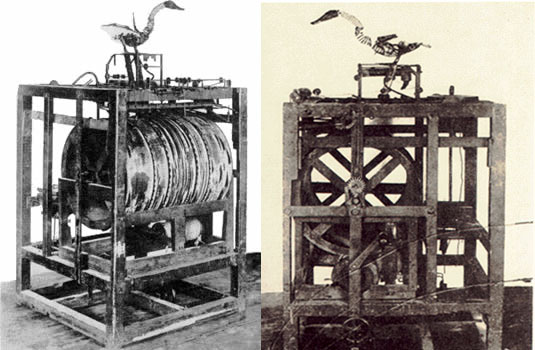 Undated photographs of what is purported to be Vaucanson%u2019s duck. The images seem to fit with Goethe%u2019s description of seeing it in 1805, %u201Cwithout feathers %u2026 like a skeleton%u201D
Undated photographs of what is purported to be Vaucanson%u2019s duck. The images seem to fit with Goethe%u2019s description of seeing it in 1805, %u201Cwithout feathers %u2026 like a skeleton%u201D
Although none of Vaucanson’s automata survive, their cousins do. Among these are three androids designed in the 1770s by a Swiss clockmaking family named Jaquet-Droz: a lady “Musician” and two little boys, a “Writer” and a “Draughtsman”. The “Writer” can be arranged to write any message of up to forty characters; the “Draughtsman” sketches four pictures in charcoal; and the “Musician” plays several airs on a harpsichord. The trio is eerily lifelike, and still hold court in Neuchatel, Switzerland. Their eyes follow their fingers as they work, the “Draughtsman” blows the charcoal dust from his page periodically, and the “Musician” seems to sigh with emotion as she plays (she actually breathes for an hour before and after the act, giving spectators a certain frisson as they arrive and depart).
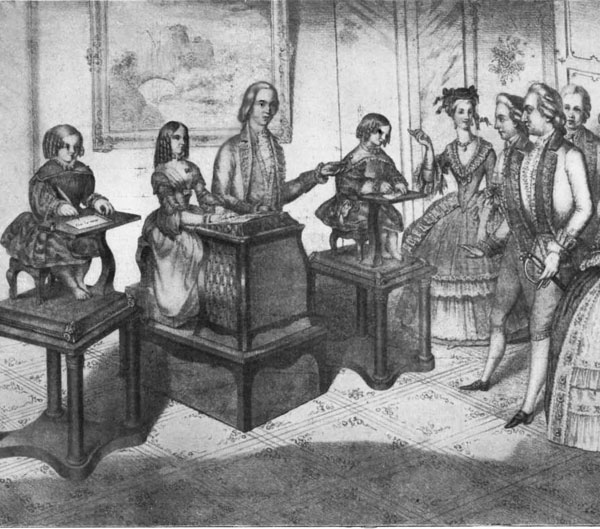 Jaquet-Droz at the court of Louis XV with his automata (left to right): the %u201CWriter%u201D, the %u201CMusician%u201D, and the %u201CDraughtsman%u201D %u2014 a lithograph reproduced in Scientific American, Vol. 88, Number 16 (April 1903)
Jaquet-Droz at the court of Louis XV with his automata (left to right): the %u201CWriter%u201D, the %u201CMusician%u201D, and the %u201CDraughtsman%u201D %u2014 a lithograph reproduced in Scientific American, Vol. 88, Number 16 (April 1903)
Later on in the eighteenth century, engineers and automaton makers became concerned with trying to mechanize two processes deemed the epitome of living intelligence: speech and chess-playing. A flurry of talking heads in the 1770s, ‘80s and ‘90s was triggered by a prize competition sponsored by the St Petersburg Academy of Sciences for a machine that could produce the sound of vowels. People went far beyond just vowels. A Frenchman named Mical designed a pair of talking heads in 1778.
They contained “artificial glottises arranged over taut membranes”, but their dialogue in praise of Louis XVI was rather dull: “The King gives Peace to Europe”, intoned the first head; “Peace crowns the King with Glory”, replied the second; and so on.
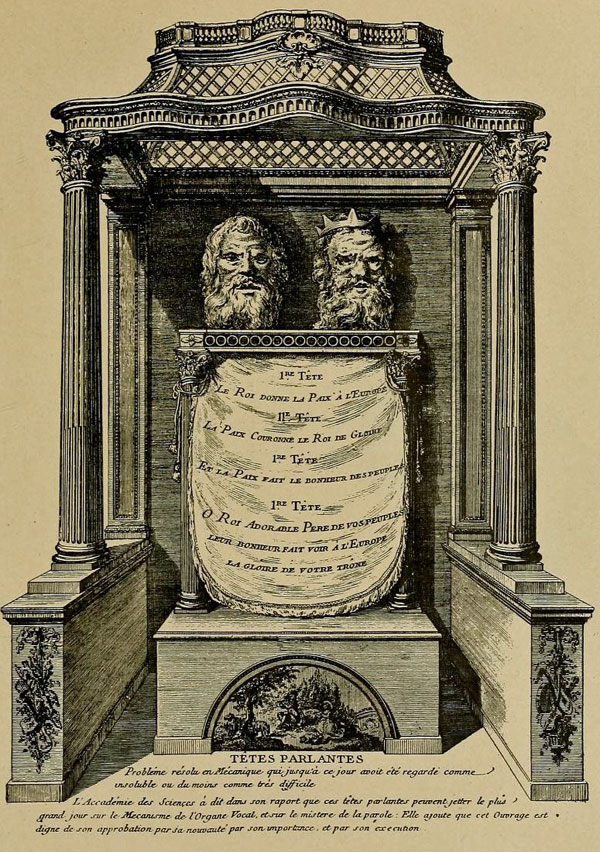 Contemporary depiction of Mical%u2019s heads, reproduced in Henry Ren� d%u2019Allemagne%u2019s Histoire des jouets (1902)
Contemporary depiction of Mical%u2019s heads, reproduced in Henry Ren� d%u2019Allemagne%u2019s Histoire des jouets (1902)
About a decade later, a Hungarian engineer named Wolfgang von Kempelen designed a speaking machine using an ivory glottis, bellows for lungs, a leather vocal tract with a hinged tongue, a rubber oral cavity and mouth, and a nose with two little pipes as nostrils. Its pronouncements were more whimsical than those of Mical’s talking heads: “my wife is my friend”, for example, and “come with me to Paris”.
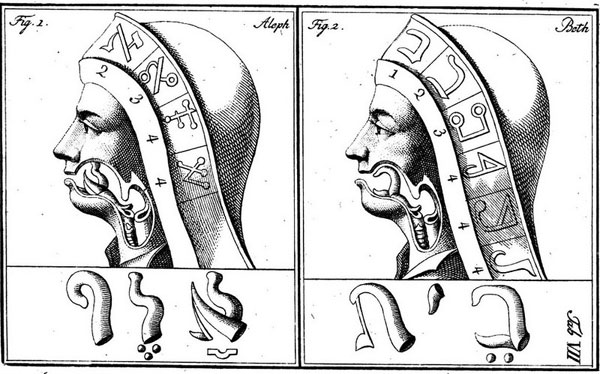 Illustration from Kempelen%u2019s Le m�canisme de la parole (1791)
Illustration from Kempelen%u2019s Le m�canisme de la parole (1791)
Kempelen was more famous for another “automaton” that he designed and built in 1769, the chess-playing Turk. This life-sized model was exhibited all over Europe and America by Kempelen himself and then by others until its demise in a fire in 1854; in the course of its long career, reportedly beating both Napoleon and Charles Babbage. Although aspects of its movement — the motion of the arms, head, etc. — were mechanical, it was not, of course, a full automaton. The crucial chess-playing aspect was the work of a succession of skillful and diminutive human chess-players concealed in its pedestal, something all but admitted by Kempelen who said his main achievement had been to create an illusion. People no doubt knew it was a hoax, but they were fascinated anyway, because it dramatized the question of the age: whether a machine could reason, and relatedly, whether the human mind might itself be a kind of machine.
Edgar Allan Poe was taken by the question and in 1836 wrote an essay about Kempelen’s Turk and Babbage’s Difference Engine. He believed a machine could calculate, because calculation was a fixed and determinate process, but not that a machine could play chess because, he said, chess was indeterminate: the machine would have to respond to its opponent’s moves. So Babbage’s machine was genuine but Kempelen’s fraudulent.
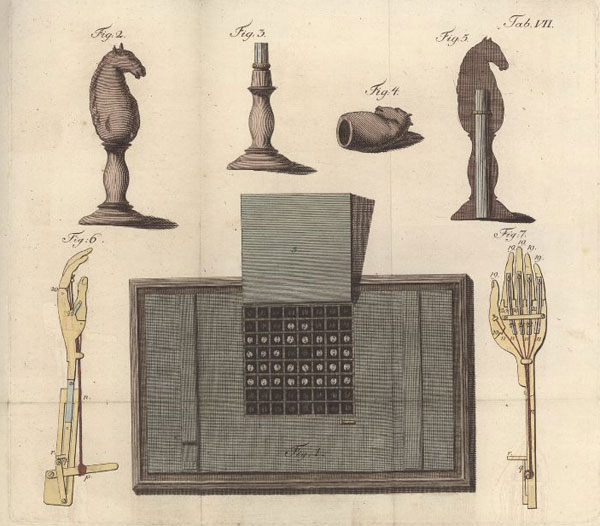 Coloured engraving from Joseph Racknitz%u2019s 1789 pamphlet which attempted to reveal the secret workings of William Kempelen%u2019s alleged chess-playing automaton %u201CThe Turk%u201D
Coloured engraving from Joseph Racknitz%u2019s 1789 pamphlet which attempted to reveal the secret workings of William Kempelen%u2019s alleged chess-playing automaton %u201CThe Turk%u201D
When I’ve assigned Poe’s essay to engineering students, they’ve found his reasoning strange: why couldn’t a machine respond to each move of its opponent? Here is another example of how people’s intuitions about the nature of life, mechanism and science continually transform. Poe assumed a machine was necessarily unresponsive. Two centuries earlier, Descartes had made the opposite assumption, and almost two centuries later, so did my students.
How should we regard Hero of Alexandria’s siphon-driven birds, the medieval automaton Christs, the Renaissance frolicsome engines, the android musicians, artists, writers and talking heads of the eighteenth century? They can certainly be seen as the ancestors of modern projects in robotics and artificial intelligence. But they were also expressions of a very different mode of understanding. Rather than the concepts of programming, feedback or information so important today, they were born from other ideas: animate versus inanimate matter, willful versus constrained motion, mindless versus intelligent labor. It is hard to imagine that our own conceptual frameworks will one day seem as remote and exotic as an Aristotelian account of Hero’s siphons seems to us, but they surely will. Can knowing this perhaps help us to imagine what might come to replace information, programming and feedback as the key concepts for understanding life, sentience, mechanism and mind?
This article was originally published in the Public Domain Review under a CC-BY-SA licence

Rate and Review
Rate this article
Review this article
Log into OpenLearn to leave reviews and join in the conversation.
Article reviews